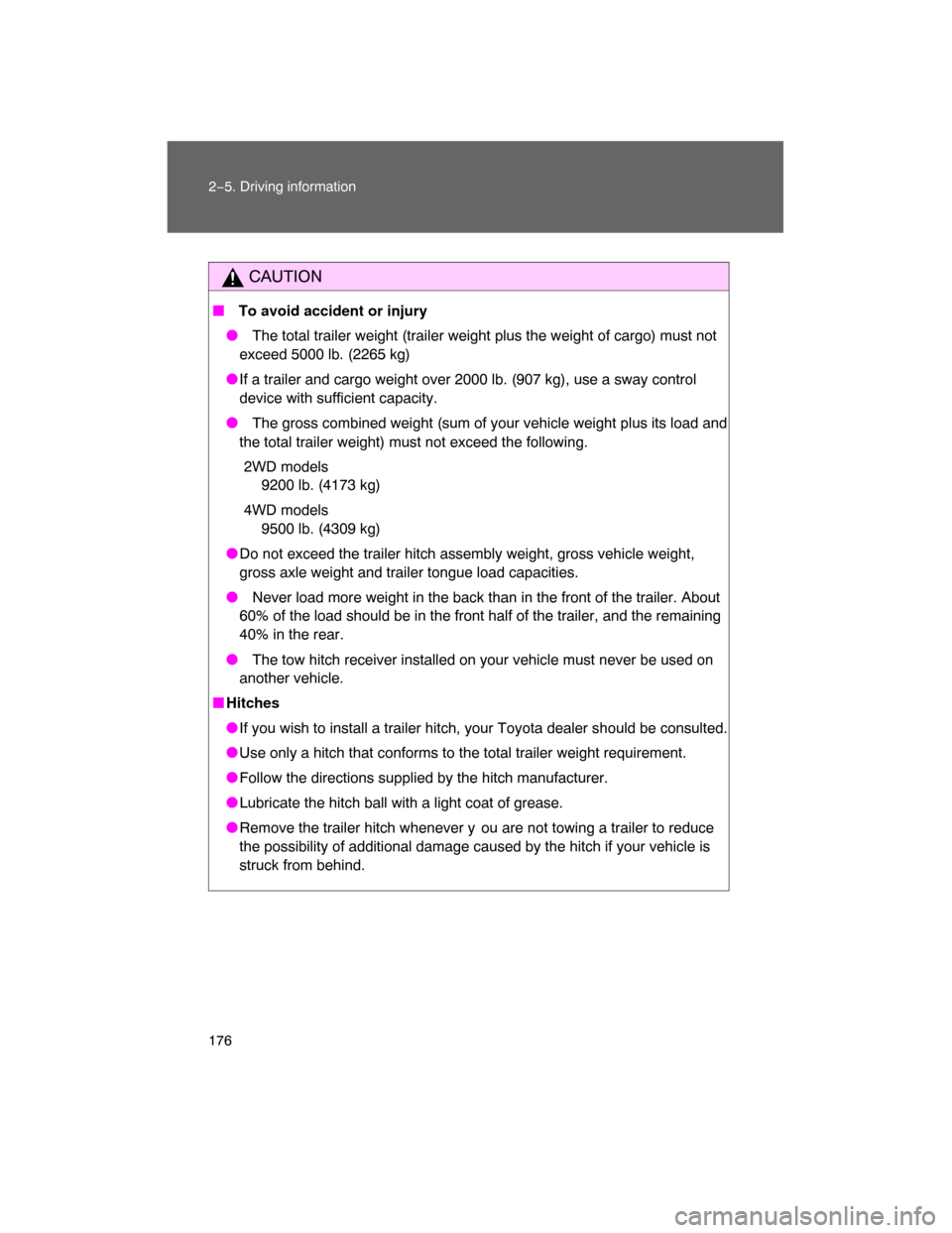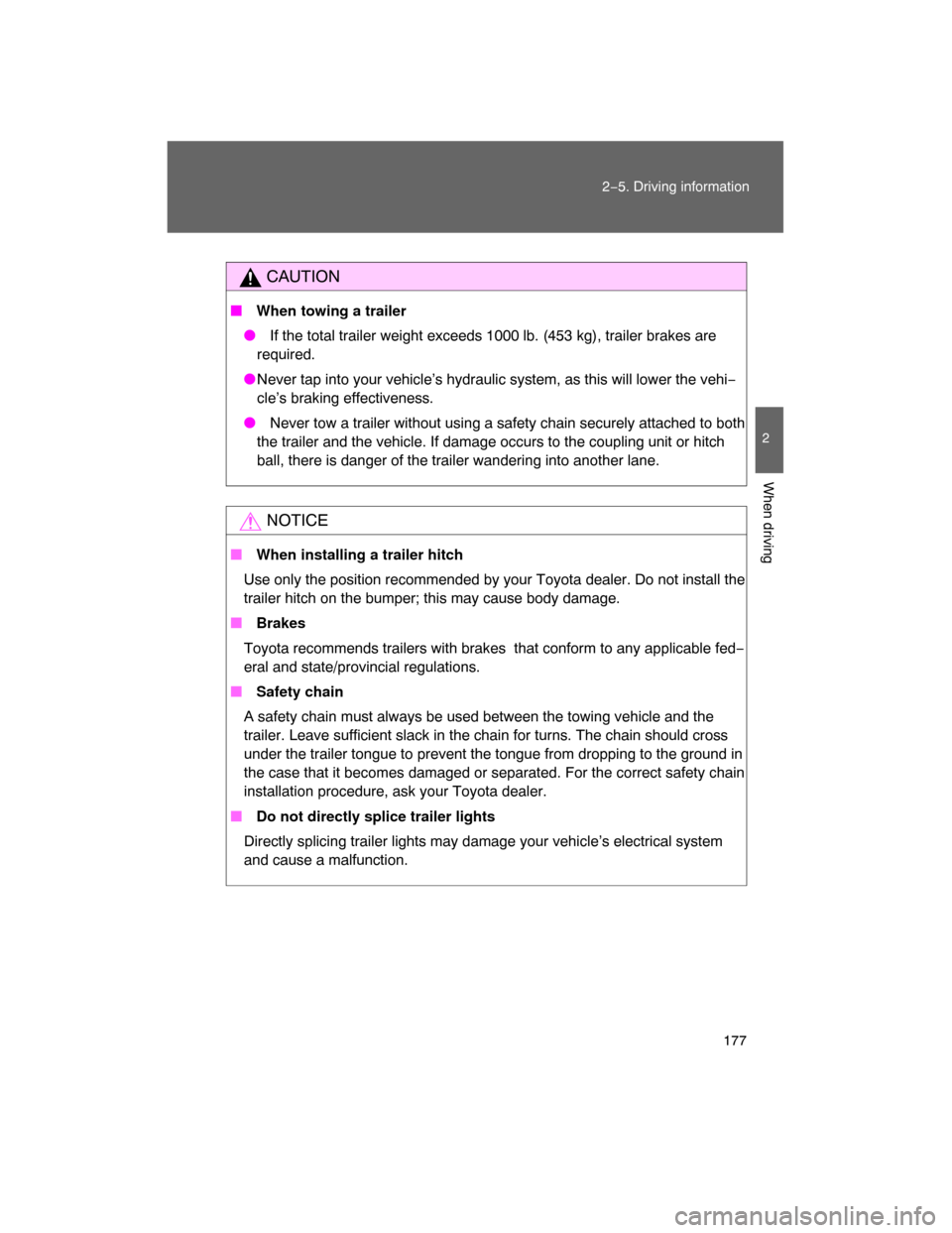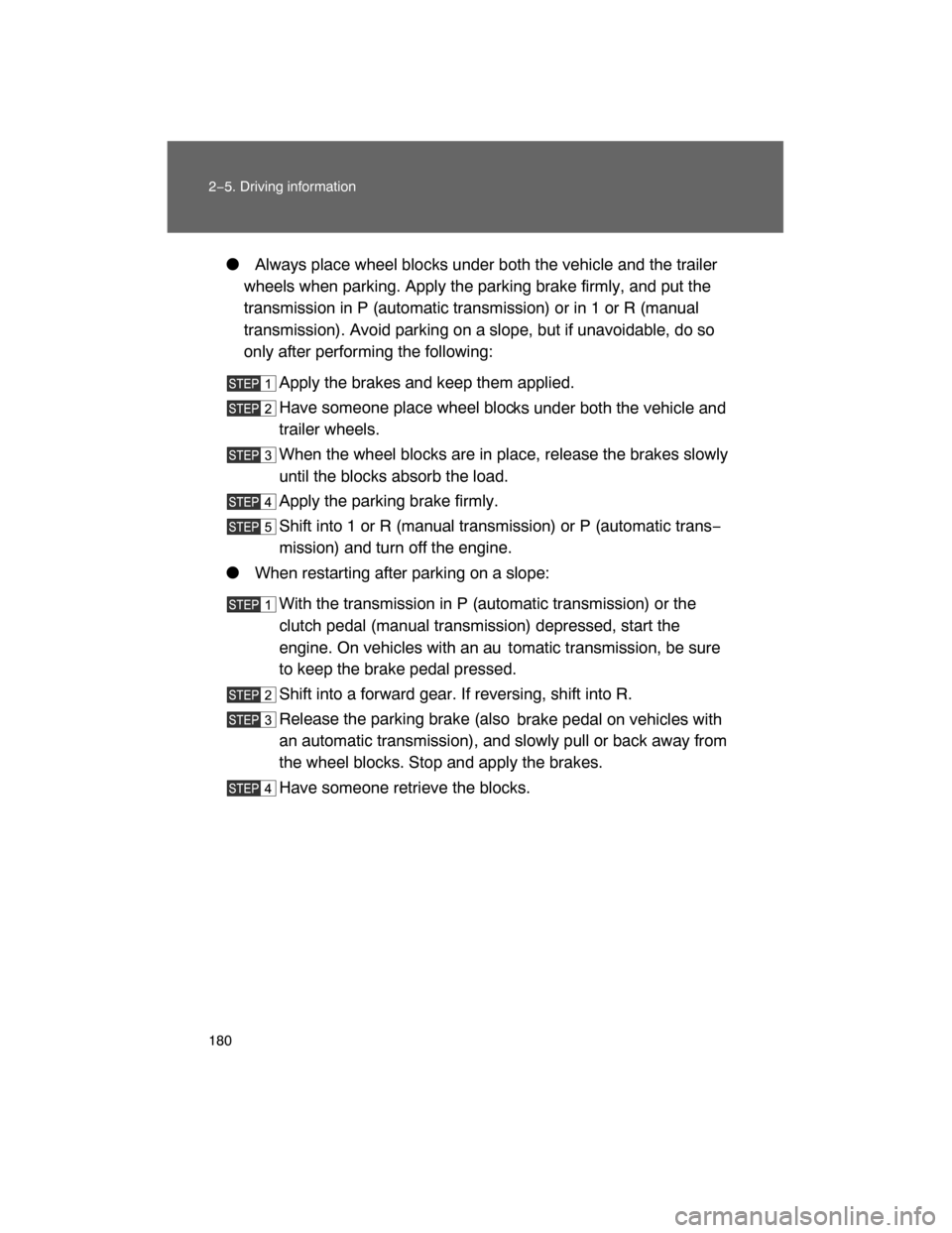Page 174 of 400

176 2−5. Driving information
CAUTION
� To avoid accident or injury
� The total trailer weight (trailer weight plus the weight of cargo) must not
exceed 5000 lb. (2265 kg)
�If a trailer and cargo weight over 2000 lb. (907 kg), use a sway control
device with sufficient capacity.
� The gross combined weight (sum of your vehicle weight plus its load and
the total trailer weight) must not exceed the following.
2WD models
9200 lb. (4173 kg)
4WD models
9500 lb. (4309 kg)
�Do not exceed the trailer hitch assembly weight, gross vehicle weight,
gross axle weight and trailer tongue load capacities.
� Never load more weight in the back than in the front of the trailer. About
60% of the load should be in the front half of the trailer, and the remaining
40% in the rear.
� The tow hitch receiver installed on your vehicle must never be used on
another vehicle.
�Hitches
�If you wish to install a trailer hitch, your Toyota dealer should be consulted.
�Use only a hitch that conforms to the total trailer weight requirement.
�Follow the directions supplied by the hitch manufacturer.
�Lubricate the hitch ball with a light coat of grease.
�
Remove the trailer hitch whenever y ou are not towing a trailer to reduce
the possibility of additional damage caused by the hitch if your vehicle is
struck from behind.
Page 175 of 400

177
2−5. Driving information
2
When driving
CAUTION
� When towing a trailer
� If the total trailer weight exceeds 1000 lb. (453 kg), trailer brakes are
required.
�Never tap into your vehicle’s hydraulic system, as this will lower the vehi−
cle’s braking effectiveness.
� Never tow a trailer without using a safety chain securely attached to both
the trailer and the vehicle. If damage occurs to the coupling unit or hitch
ball, there is danger of the trailer wandering into another lane.
NOTICE
� When installing a trailer hitch
Use only the position recommended by your Toyota dealer. Do not install the
trailer hitch on the bumper; this may cause body damage.
� Brakes
Toyota recommends trailers with brakes that conform to any applicable fed−
eral and state/provincial regulations.
� Safety chain
A safety chain must always be used between the towing vehicle and the
trailer. Leave sufficient slack in the chain for turns. The chain should cross
under the trailer tongue to prevent the tongue from dropping to the ground in
the case that it becomes damaged or separated. For the correct safety chain
installation procedure, ask your Toyota dealer.
� Do not directly splice trailer lights
Directly splicing trailer lights may damage your vehicle’s electrical system
and cause a malfunction.
Page 176 of 400

178 2−5. Driving information
Trailer towing tips
Your vehicle will handle differently when towing a trailer. The three
main causes of vehicle−trailer ac cidents are driver error, excessive
speed and improper trailer loading. Keep these in mind when towing.
�
Before starting out, check the trailer ’s light and the vehicle−trailer
connections. Recheck after driving a short distance.
� Practice turning, stopping and reve rsing with the trailer attached in
an area away from traffic until you become accustomed to the feel
of the vehicle.
� Reversing with a trailer attached is
difficult and requires practice.
Grip the bottom of the steering wheel and move your hand to the
left to move the trailer to the left. Move your hand to the right to
move the trailer to the right. (This generally opposite to reversing
without a trailer attached.) Avoid sharp or prolonged turning. Have
someone guide you when reversing to reduce the risk of an acci−
dent.
� As stopping distance is increased when towing a trailer, vehicle−to−
vehicle distance should be increased. For each 10 mph (16 km/h)
of speed, allow at least o
ne vehicle and trailer length.
� Avoid sudden braking as you may skid, resulting in jackknifing and
loss of control. This is especially true on wet or slippery surfaces.
�
Avoid jerky starts or sudden acceleration. Vehicles with a manual
transmission, prevent excessive cl
utch slippage by keeping engine
rpm low and not racing the engine. Always start out in first gear.
�Avoid jerky steering and sharp turns, and slow down before mak−
ing a turn.
Page 177 of 400

179
2−5. Driving information
2
When driving
� Note that when making a turn, the trailer wheels will be closer than
the vehicle wheels to the inside of the turn. Compensate by making
a larger than normal turning radius.
� Crosswinds and rough roads will adversely affect handling of your
vehicle and trailer, causing sway . Periodically check the rear to
prepare for being passed by large trucks or buses, which may
cause your vehicle and trailer to sway. If swaying occurs, firmly grip
the steering wheel, reduce speed immediately but gradually, and
steer straight ahead. Never increase speed. If you make no
extreme correction with the stee ring or brakes, your vehicle and
trailer will stabilize.
�Take care when passing other vehicles. Passing requires consider−
able distance. After passing a vehicle, do not forget the length of
your trailer, and be sure you hav
e plenty of room before changing
lanes.
�
In order to maintain engine braking efficiency, do not use the trans−
mission in D (automatic transmiss
ion) or 6 (manual transmission).
� Due to the added load of the trailer, your vehicle’s engine may
overheat on hot days (at temperatures over 85°F [30°C]) when
driving up a long or steep grade. If the engine coolant temperature
gauge indicates overheating, immedi
ately turn off the air condition−
ing (if in use), pull your vehicle off the road and stop in a safe spot.
(
P. 356)
Page 178 of 400

180 2−5. Driving information
� Always place wheel blocks under both the vehicle and the trailer
wheels when parking. Apply the parking brake firmly, and put the
transmission in P (automatic transmission) or in 1 or R (manual
transmission). Avoid parking on a slope, but if unavoidable, do so
only after performing the following:
Apply the brakes and keep them applied.
Have someone place wheel bloc
ks under both the vehicle and
trailer wheels.
When the wheel blocks are in place, release the brakes slowly
until the blocks absorb the load.
Apply the parking brake firmly.
Shift into 1 or R (manual transmission) or P (automatic trans−
mission) and turn off the engine.
� When restarting after parking on a slope:
With the transmission in P (automatic transmission) or the
clutch pedal (manual transmission) depressed, start the
engine. On vehicles with an au tomatic transmission, be sure
to keep the brake pedal pressed.
Shift into a forward gear. If reversing, shift into R.
Release the parking brake (also
brake pedal on vehicles with
an automatic transmission), and slowly pull or back away from
the wheel blocks. Stop and apply the brakes.
Have someone retrieve the blocks.
Page 179 of 400
181
2−5. Driving information
2
When driving
CAUTION
� To avoid an accident
� Do not exceed 45 mph (72 km/h) or posted towing speed limit, whichever
is lower. As instability (swaying) of the towing vehicle−trailer combination
increases as speed increases, exceeding 45 mph (72 km/h) may cause
loss of control.
� Slow down and downshift before descending steep or long downhill
grades. Do not make sudden downshifts.
�
Avoid holding the brake pedal down too long or too frequently. This could
cause the brakes to overheat and result in reduced braking efficiency.
Page 304 of 400

308 4−3. Do−it−yourself maintenance
FuseAmpere Circuit
1 SPARE 10 A Spare fuse
2 SPARE 15 A Spare fuse
3 TOWING TAIL 15 A Trailer lights
4 OFFROAD LP 15 A Offroad lamp
5 STOP 10 AStop lights, high mounted stop−
light, anti−lock brake system, trac−
tion control system, active traction
control system, vehicle stability
control system, AUTO LSD system,
multiport fuel injection system/
sequential multiport fuel injection
system, shift lock system
6 AUX LP 15 A Driving lamp
7 OBD 7.5 A On−board diagnosis system
8 HEAD (LO RH) 10 ARight−hand headlight (low beam)
*1
Right−hand headlight*2
9 HEAD (LO LH) 10 ALeft−hand headlight (low beam)
*1
Left−hand headlight*2
10 HEAD (HI RH) 10 A Right−hand headlight (high beam)
11 HEAD (HI LH) 10 A Left−hand headlight (high beam)
12 EFI NO.2 10 AMultiport fuel injection system/
sequential multiport fuel injection
system
13 DRL 7.5 A Daytime running light system
14 DEFOG 30 A Rear window defogger
15 DEFOG NO.2 7.5 AMultiport fuel injection system/
sequential multiport fuel injection
system
16 DOME 10 A
Interior light, luggage compartment
light, clock, accessory meter, meter
and gauge
Page 356 of 400
362
6−1. Specifications
Maintenance data (fuel, oil level, etc.)
Dimensions and weight
*: Unladen vehicle
Overall length 183.9 in. (4670 mm)
Overall width 75.0 in. (1905 mm)
Overall
height*2WD models 71.3 in. (1810 mm)
4WD models 72.0 in. (1830 mm)
Wheelbase 105.9 in. (2690 mm)
Front tread 63.2 in. (1605 mm)
Rear tread 63.2 in. (1605 mm)
Vehicle capacity weight
(Occupants + luggage)
1190 lb. (540 kg)
Towing capacity
(Trailer weight + cargo)
5000 lb. (2265 kg)